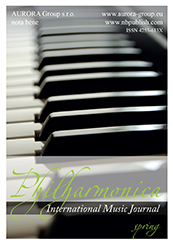Philosophy of Music
Reference:
Li Y.
European trends in Chinese music of the “New Wave” of the 20th - early 21st centuries
// PHILHARMONICA. International Music Journal.
2024. ¹ 3.
P. 1-10.
DOI: 10.7256/2453-613X.2024.3.70775 EDN: DQXMWW URL: https://en.nbpublish.com/library_read_article.php?id=70775
Abstract:
The article describes the generation of Chinese composers of the period of «Opening up and Reform», who are usually called the «Class of 1978». This historical moment, which determined the turn of Chinese new music into the possibility of interaction with the European avant-garde, is described from the perspective of the most prominent composers of the generation: Chen Yi, Tang Dun, Guo Wenjing. The article defines the trajectories of new music, which Chinese composers then follow, their musical reference points, initial reliance on the classical-romantic European tradition, following new trajectories in the development of compositional technique, reliance on folklorism and orientation to the work of Bela Bartok. Among the leaders who determined the face of new Chinese music, Alexander Goer and Zhou Wenchun are described, and their influence on young composers, which determined the creative fate of the latter, is also emphasized. The purpose of the study is to determine the features of the development of new music in China after the Cultural Revolution. The scientific novelty of the study lies in the fact that for the first time a comprehensive analysis of the history of the composer generation «Class of 1978» is carried out. New facts are presented from the biographies of Tang Dun, Guo Wenjing and Chen Ying. This allows us to take a fresh look at the work of Chinese composers of the 1980s and their interactions with European art. As a result of the study, it was proven that the period of «Opening up and Reform» became an era of musical innovation, and the compositional individuals generated by this era surpassed their predecessors and teachers, both in terms of new concepts and in terms of mastery of compositional technique and brought Chinese music into the world artistic space.
Keywords:
musical education, folklore, Zhou Wenchun, Alexander Goer, Chen Yin, Zhou Lu, Guo Wenjing, Tang Dun, New Wave, Chinese music
History of Music
Reference:
Shkirtil' L.V., Serov Y.E.
Performing aspects of V. Gavrilin’s “Russian Notebook”: dramaturgy, theatricalization, peasant song, folklore genres
// PHILHARMONICA. International Music Journal.
2024. ¹ 3.
P. 11-25.
DOI: 10.7256/2453-613X.2024.3.70964 EDN: KVWIFT URL: https://en.nbpublish.com/library_read_article.php?id=70964
Abstract:
The article is devoted to one of the most important Russian chamber vocal cycles of the second half of the twentieth century – “Russian Notebook” by V. Gavrilin. Its appearance in 1965 made a strong impression on both the musical community and listeners. Everything about her was unusual, fresh, sincere. The stylistic unity of the “Russian Notebook” is due to its reliance on folk sources – literary texts and musical material. Gavrilin interpreted folk music in a deeply personal way, refracted it through the prism of a powerful spiritual and moral concept, outlined new directions for its research and comprehension, and proposed multi-valued interpretations and unexpected syntheses. “Russian Notebook” became the most important component of the significant artistic movement “new folk wave” that appeared in Russian music at the turn of the 1960s. Its brightest representatives were the “sixties” composers R. Shchedrin, E. Denisov, B. Tishchenko, S. Slonimsky. The main conclusion of the study is the idea that V. Gavrilin’s “Russian Notebook” is a genuine encyclopedia of folk genres. The composer penetrates deeply into the folk song tradition, organically refracts folklore, passes it through his amazing artistic world, thereby making the folklore language accessible to the general public. The author of the article focuses on the performing aspects of V. Gavrilin’s cycle, on the variety of interpretive possibilities coming from the diversity of folk (primarily peasant) song. The vocalist and accompanist-pianist need to seriously study the folk traditions before taking on the “Russian Notebook”. The intense dramaturgy of the cycle and the theatricalization of vocal music should also be the focus of the performers’ attention. V. Gavrilin’s composition opens up new interpretive paths and possibilities, new vocal techniques, and creates a multi-tasking performing world.
Keywords:
Vanguard, Mezzo-soprano, Peasant song, Folklore genres, Folk art, New folk wave, Russian music, Vocal cycle, Valery Gavrilin, Piano
Problems of Music Theory
Reference:
Veretennikov S., Savost'yanov M.A.
Prelude Op. 3 No. 2 by Sergei Rachmaninoff and Prelude Op. 11 No. 10 by Alexander Scriabin: Two Facets of Drama
// PHILHARMONICA. International Music Journal.
2024. ¹ 3.
P. 26-34.
DOI: 10.7256/2453-613X.2024.3.71069 EDN: LJDFTS URL: https://en.nbpublish.com/library_read_article.php?id=71069
Abstract:
The two considered dramatic preludes were written by the young Sergei Rachmaninov and Alexander Scriabin almost simultaneously, with a difference of two years. The article examines the interrelationships and features of these two plays. The basis for the joint study of these miniatures is the same tonality (C-sharp minor), one genre definition, as well as several similar features in imagery (drama) and the dramatic idea (the juxtaposition of the "fatal" beginning and the pleading voice). The interrelations are manifested in form, texture, harmony, and specific compositional techniques. On the other hand, distinctive features are also studied in the form, texture, harmony, concert scale, and features of the melodic relief of these compositions. An attempt is made to substantiate the specificity of the plays' figurative and semantic content by the musical language's peculiarities. Rachmaninov's prelude, Op. 3 No. 2 and Scriabin's prelude Op. 11 No. 10 are studied by comparison. The method of sequential comparison makes it possible to study the interrelationships in detail and clearly identify the features and individuality of each miniature's symbolic and semantic content and musical language. For the first time, these two famous preludes are compared in detail, sequentially, in the context of each part. It can be argued that preludes have several similar features (dramatic, compositional, textural) that have not been discussed before. As a result of the comparison, both the peculiarities of imagery and the peculiarities of musical language are highlighted in a new way. A number of these features will later, in the course of the evolution of creativity, become distinctive features of the compositional styles of each of the authors. Due to these individual characteristics, one dramatic idea is embodied in each of these preludes in its own way: the idea of contrasting and further interaction of two contrasting images—"rock" and "supplication"—is embodied in each prelude in its own way. These features emphasize the difference, like the drama of each play. This difference is related to the individuality of creativity's emotional, symbolic, and semantic content and the specifics of the aesthetic positions of the two Russian contemporary composers.
Keywords:
drama, organ point, comparison, symbolism, basses, harmony, peculiarities of musical language, bell-ringing, texture, prelude
 This work is licensed under a Creative Commons Attribution-NonCommercial 4.0 International License.
This work is licensed under a Creative Commons Attribution-NonCommercial 4.0 International License.












 © 1998 – 2024 Nota Bene. Publishing Technologies. NB-Media Ltd.
© 1998 – 2024 Nota Bene. Publishing Technologies. NB-Media Ltd.




